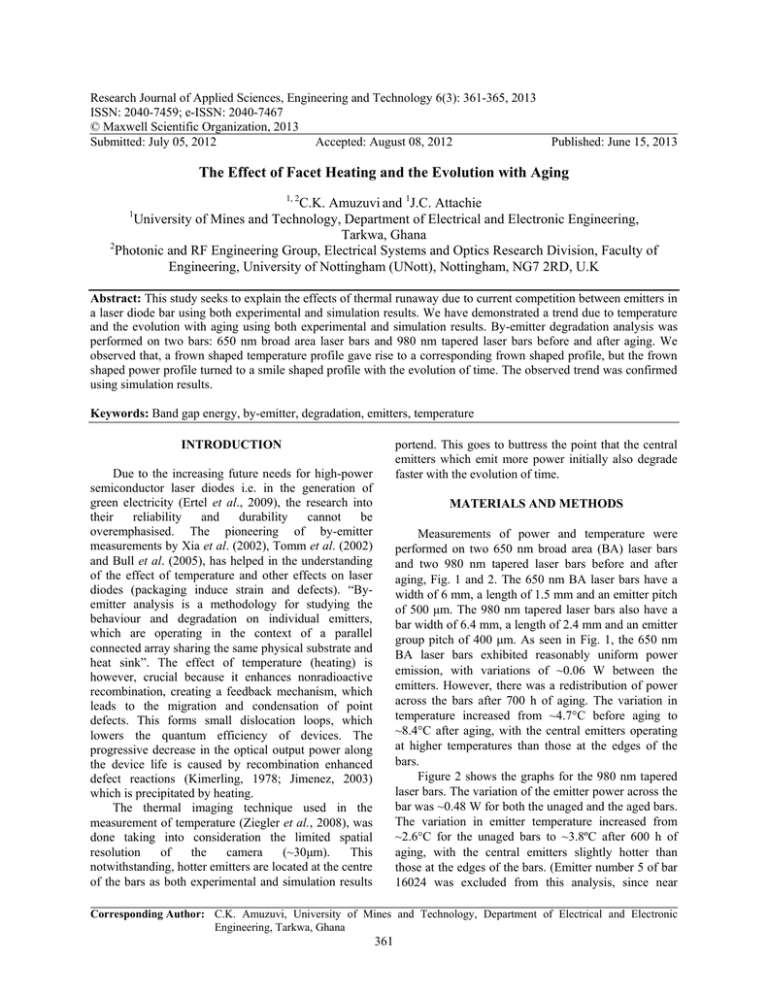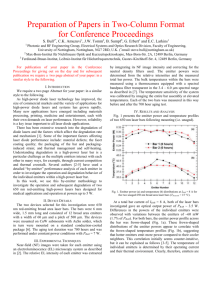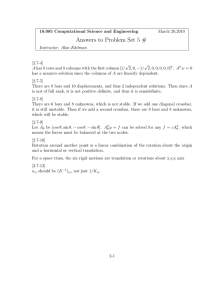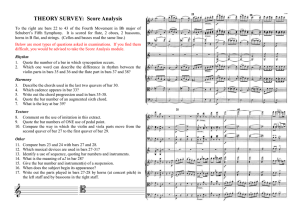Research Journal of Applied Sciences, Engineering and Technology 6(3): 361-365,... ISSN: 2040-7459; e-ISSN: 2040-7467
advertisement

Research Journal of Applied Sciences, Engineering and Technology 6(3): 361-365, 2013 ISSN: 2040-7459; e-ISSN: 2040-7467 © Maxwell Scientific Organization, 2013 Submitted: July 05, 2012 Accepted: August 08, 2012 Published: June 15, 2013 The Effect of Facet Heating and the Evolution with Aging 1, 2 C.K. Amuzuvi and 1J.C. Attachie University of Mines and Technology, Department of Electrical and Electronic Engineering, Tarkwa, Ghana 2 Photonic and RF Engineering Group, Electrical Systems and Optics Research Division, Faculty of Engineering, University of Nottingham (UNott), Nottingham, NG7 2RD, U.K 1 Abstract: This study seeks to explain the effects of thermal runaway due to current competition between emitters in a laser diode bar using both experimental and simulation results. We have demonstrated a trend due to temperature and the evolution with aging using both experimental and simulation results. By-emitter degradation analysis was performed on two bars: 650 nm broad area laser bars and 980 nm tapered laser bars before and after aging. We observed that, a frown shaped temperature profile gave rise to a corresponding frown shaped profile, but the frown shaped power profile turned to a smile shaped profile with the evolution of time. The observed trend was confirmed using simulation results. Keywords: Band gap energy, by-emitter, degradation, emitters, temperature portend. This goes to buttress the point that the central emitters which emit more power initially also degrade faster with the evolution of time. INTRODUCTION Due to the increasing future needs for high-power semiconductor laser diodes i.e. in the generation of green electricity (Ertel et al., 2009), the research into their reliability and durability cannot be overemphasised. The pioneering of by-emitter measurements by Xia et al. (2002), Tomm et al. (2002) and Bull et al. (2005), has helped in the understanding of the effect of temperature and other effects on laser diodes (packaging induce strain and defects). “Byemitter analysis is a methodology for studying the behaviour and degradation on individual emitters, which are operating in the context of a parallel connected array sharing the same physical substrate and heat sink”. The effect of temperature (heating) is however, crucial because it enhances nonradioactive recombination, creating a feedback mechanism, which leads to the migration and condensation of point defects. This forms small dislocation loops, which lowers the quantum efficiency of devices. The progressive decrease in the optical output power along the device life is caused by recombination enhanced defect reactions (Kimerling, 1978; Jimenez, 2003) which is precipitated by heating. The thermal imaging technique used in the measurement of temperature (Ziegler et al., 2008), was done taking into consideration the limited spatial resolution of the camera (~30μm). This notwithstanding, hotter emitters are located at the centre of the bars as both experimental and simulation results MATERIALS AND METHODS Measurements of power and temperature were performed on two 650 nm broad area (BA) laser bars and two 980 nm tapered laser bars before and after aging, Fig. 1 and 2. The 650 nm BA laser bars have a width of 6 mm, a length of 1.5 mm and an emitter pitch of 500 μm. The 980 nm tapered laser bars also have a bar width of 6.4 mm, a length of 2.4 mm and an emitter group pitch of 400 μm. As seen in Fig. 1, the 650 nm BA laser bars exhibited reasonably uniform power emission, with variations of ~0.06 W between the emitters. However, there was a redistribution of power across the bars after 700 h of aging. The variation in temperature increased from ~4.7°C before aging to ~8.4°C after aging, with the central emitters operating at higher temperatures than those at the edges of the bars. Figure 2 shows the graphs for the 980 nm tapered laser bars. The variation of the emitter power across the bar was ~0.48 W for both the unaged and the aged bars. The variation in emitter temperature increased from ~2.6°C for the unaged bars to ~3.8ºC after 600 h of aging, with the central emitters slightly hotter than those at the edges of the bars. (Emitter number 5 of bar 16024 was excluded from this analysis, since near Corresponding Author: C.K. Amuzuvi, University of Mines and Technology, Department of Electrical and Electronic Engineering, Tarkwa, Ghana 361 Res. J. Appl. Sci. Eng. Technol., 6(3): 361-365, 2013 o Temperature (deg.C) Temperature (deg.C) Emitter power (W) Emitter power (W) I = 8 A, Ths = 15 C 0.32 0.30 0.28 0.26 0.24 0.22 0.32 0.30 0.28 0.26 0.24 0.22 46.0 44.0 42.0 40.0 38.0 36.0 34.0 42.0 (A) 0519 Unaged 0519 Aged (b) 0521 Unaged 0521 Aged (c) 0519 Unaged 0519 Aged (d) 40.0 0521 Unaged 0521 Aged 38.0 36.0 1 2 3 4 5 6 7 8 9 Emitter Number 10 11 12 Fig. 1: Power distribution of the 650 nm broad area laser bars using 8 A bias current for (a) 0 hours aging, (b) 700 h aging; and temperature distributions for, (c) 0 hours aging and (d) 700 h aging against the number of emitters within the laser bar Temperature (deg.C) Temperature (deg.C) Emitter power (W) Emitter power (W) I = 25 A, Ths = 25 oC 1.2 1.0 0.8 0.6 0.4 (a) 16024 Unaged 16024Aged 1.2 (b) 1.0 0.8 0.6 0.4 46.0 44.0 (c) 42.0 30.0 38.0 36.0 34.0 40.0 (d) 16025 Unaged 16025 Aged 16024 Unaged 16024 Aged 38.0 36.0 16025 Unaged 16025Aged 34.0 1 2 3 4 5 6 7 8 9 10 11 12 13 14 15 16 Emitter Number Fig. 2: Power distribution of the 980 nm tapered laser bars using 25 A bias current for (a) 0 h aging, (b) 600 h aging; and temperature distributions for, (c) 0 h aging and (d) 600 h aging against the number of emitters within the laser bar 362 Res. J. Appl. Sci. Eng. Technol., 6(3): 361-365, 2013 infra-red electroluminescence measurements showed that it has a high defect density.) Figure 1 and 2 show a frown-shaped profile for the power and temperature distributions in all of the unaged bars, although the frown was not as pronounced in the 980 nm bars. The emitters at the centres of the bars are hottest, because they are also heated by the neighbouring emitters. The band gap energy (E g ) drops with increasing temperature (Varshni, 1967), which reduces the turn-on voltage of the hotter emitters. This explains why the central emitters in a bar tend to have more power than those at the edges of bars, resulting in the frown-shaped (Amuzuvi et al., 2011) power emission profiles of the unaged bars. A different trend in the power profile emerges as the laser bars are aged. During aging, the frown-shaped power profile of the bar often changes towards a smileshaped profile. This is due to the accelerated degradation of the central emitters, which is caused by their elevated temperature and current/power. Although this aging behaviour is more apparent for the 650 nm bars, the power profiles of the 980 nm bars also show a tendency to go from a “frown shape” to a “smile shape” (Fig. 2a and b). The centre emitters degrade faster because of their elevated temperature and the fact that they are driven harder. Consequently, the nonradioactive recombination rate increases in the central emitters. In turn, this increases their heat generation rate, which is apparent from their increased temperature after aging. This is more evident in the 650 nm bars than in the 980 nm bars, which may be related to their lower electro-optical efficiency. (The wall-plug efficiency of the 650 nm bars was <20%, whereas that of the 980 nm bars was >35%). This means that more than 80% of the electrical energy went into the generation of heat in the 650 nm bars, compared to <65% for the 980 nm bars. Their elevated temperature may not be the only reason for the rapid degradation of the central emitters of the 650 nm bars, but it plays an important role. As shown in Fig. 1a and b, a stronger smile-shaped power profile emerges with a correspondingly larger temperature variation of ~6.6°C. A more gradual degradation in the central emitters (flat profile at the centre) for the 980 nm bars is shown in Fig. 2a and b. It must be noted though, that the different material systems used in the laser fabrication and packaging also play a role in the emitter degradation profiles achieved. The 650 nm emitting devices were mounted on CuW passively cooled heat sinks with AuSn solder (i.e., laser diode bar and CuW submount) is mounted on a standard conduction cooled package with a footprint of 25×25 mm2 (Sumpf et al., 2007). However, the 980 nm tapered laser bars were mounted with In solder on Cu heat sinks with active cooling (Stiers and Kanskar, 2005). RESULTS AND DISCUSSION Actually, red laser bars tend to degrade faster than 980 nm bars. It is not entirely clear why this is, but it could be related to: 1. different materials, 2. higher photon energy etc. Even though the current density is far higher for the 980 nm bars (J ≅ 1103 A/cm2), the 650 nm bars (J ≅ 740 A/cm2) degraded faster. The 650 nm bars had power losses of 15.3 – 18.8% after 700 h of operation, whereas the 980 nm bars lost only 5.3 – 8.8% after 600 h. It must also be noted that the area of the 980 nm bar (15.4 mm2) is larger than that of the 650 nm bars (9 mm2), so this also affects how hot the bars get. The trend shown in the experimental results were emulated using a multiple emitter scenario with 8 emitters for a calibrated 980 nm tapered laser bar. This was done to confirm the aging trends exhibited in the experimental results of both bars. The laser structure used for the emulation is the same as the 980 nm tapered bars in the experiment. The effect of thermal cross-talk between the emitters is clearly demonstrated in the simulation results with the current passing through each emitter known as shown in Fig. 3c. Figure 3 also shows the role of current competition in bar degradation and the behaviour of the individual emitters during aging. The eight 980 nm tapered emitters were connected in parallel with the individual emitters identical to those used in the single emitter experimental scenario. The condition used for the emulation scenario was a nonuniform (frown shaped) heat sink temperature distribution in Fig. 3a. Figure 3a show the heat sink frown shaped temperature profile and the values assigned to each emitter in the bar. Three degradation steps were performed at 0, 5,000 and 10,000 h at a constant bar current of 6 A. This means that the aging was emulated at a current of 6 A after each of the three degradation steps. Figure 3b and 3c show the output power and current distributions across the bar with respect to the emitter numbers. Calculated bar power losses of 2% and 4% were recorded at 5,000 h and 10,000 h, respectively. Figure 3 confirms the trend seen in the experimental results where the degradation is faster at the middle of the bar, which corresponds to the hotter emitters. It is surprising 363 Emitter current (A) Emitter power (W) Heatsink temperature (K) Res. J. Appl. Sci. Eng. Technol., 6(3): 361-365, 2013 I = 6 A, Ths = 25 oC 330 325 320 315 310 305 300 (a) (b) 0.48 0.46 0.44 0.42 0.40 0h 5000 h 10000 h 0.85 (c) 0.80 0.75 0.70 0h 0.65 1 2 5000 h 3 4 5 6 Emitter Number 10000 h 7 9 Fig. 3: (a) The degradation of a laser bar using a non-uniform temperature profile, (b) the power distribution between emitters during degradation using the non-uniform temperature profile of Fig. 3(a) and (c) emitter current competition using the non-uniform temperature profile of Fig. 3(a) with aging that the output power increases with temperature as the centre of the bar gets hotter and hotter. The reason for this has already been explained elsewhere (Amuzuvi et al., 2011). However, as aging progresses and degradation increases, the output power decreases especially at the middle of the bar because they degrade faster as shown in Fig. 3b. REFERENCES Amuzuvi, C.K., S. Bull, J.W. Tomm, J. Nagle, E.C. Larkins, B. Sumpf, G. Erbert, N. Michel and M. Krakowski, 2011. The impact of temperature and strain-induced band gap variations on current competition and emitter power in laser bars. Appl. Phys. Lett., 98(24). Bull, S., J.W. Tomm, M. Oudart, J. Nagle, C. Scholz, K. Boucke, I. Harrison and E.C. Larkins, 2005. By-emitter degradation analysis of high-power laser bars. J. Appl. Phys., 98: 063101. Ertel, K., S. Banerjee, P.D. Mason, C. HernandezGomez and J.L. Collier, 2009. 2nd High Power Diode Lasers and Systems Meeting (HPDLS). Coventry, UK, KEYNOTE. Jimenez, J., 2003. Laser diode reliability: Crystal defects and degradation modes. Comp. Rend. Phys., 4: 663-673. Kimerling, L.C., 1978. Recombination enhanced defect reactions. Solid-State Elec., 21: 13911401. Sumpf, B., M. Zorn, R. Staske, J. Fricke, P. Ressel, A. Ginolas, K. Paschke, G. Erbert, M. Weyers and G. Trankle, 2007. IEEE J. Select. Topic. Quant. Elec., 13: 1188-1193. Stiers, E. and M. Kanskar, 2005. High-Power Diode Laser Technology and Applications III. Zediker, M.S. (Ed.), SPIE Bellingham W.A., 5711: 30-36. CONCLUSION We have demonstrated a trend, which exist between a frown shaped temperature profile and the individual emitter power profile within a laser bar. Surprisingly, hotter emitters located at the centre of the bar emit more power when they are undegraded but this must not go unchecked. With aging, the frown shaped power profile turns to smile shaped with the central emitters losing power more quickly. This is completely normal because the central emitters are driven harder and therefore degrade faster. The authors gratefully acknowledge the support of the EC IST project WWW.BRIGHTER.EU (IST035266) and the Fraunhofer Institute for Laser Technology (T. Westphalen, M. Traub). Finally, CKA thanks the University of Mines and Technology, Tarkwa, Ghana and the Get Fund for their support. 364 Res. J. Appl. Sci. Eng. Technol., 6(3): 361-365, 2013 Tomm, J.W., A. Gerhardt, T. Elsaesser, D. Lorenzen and P. Hennig, 2002. Simultaneous quantification of strain and defects in high-power diode laser devices. Appl. Phys. Lett., 81: 3269-3271. Varshni, Y.P., 1967. Temperature dependence of energy gap in semiconductors. Physica, 34: 149-154. Xia, R., E.C. Larkins, I. Harrison, S.R.A. Dods, A.V. Andrianov, J. Morgan and J.P. Landesman, 2002. Mounting-induced strain threshold for the degradation of high-power AlGaAs laser bars. IEEE Photon. Technol. Lett., 14: 893. Ziegler, M., J.W. Tomm, F. Welk, T. Elsaesser, C. Monte, J. Hollandt, H. Kissel, G. Seibold and J. Biesenbach, 2008. Accurate determination of absolute temperatures of GaAs based high-power diode lasers. High-Power Diode Laser Technol. Appl. VI. Zediker, M.S. (Ed.), Proceedings of the SPIE, 6876: 68761A-68761A-8. 365







